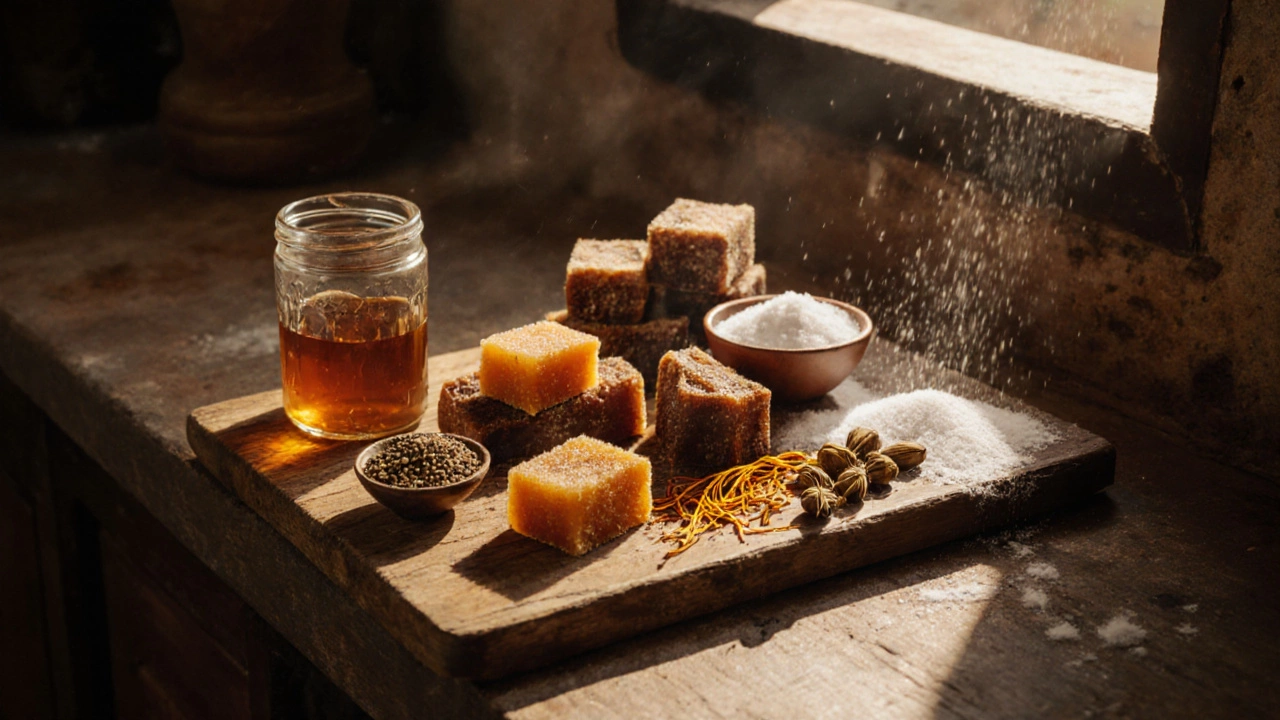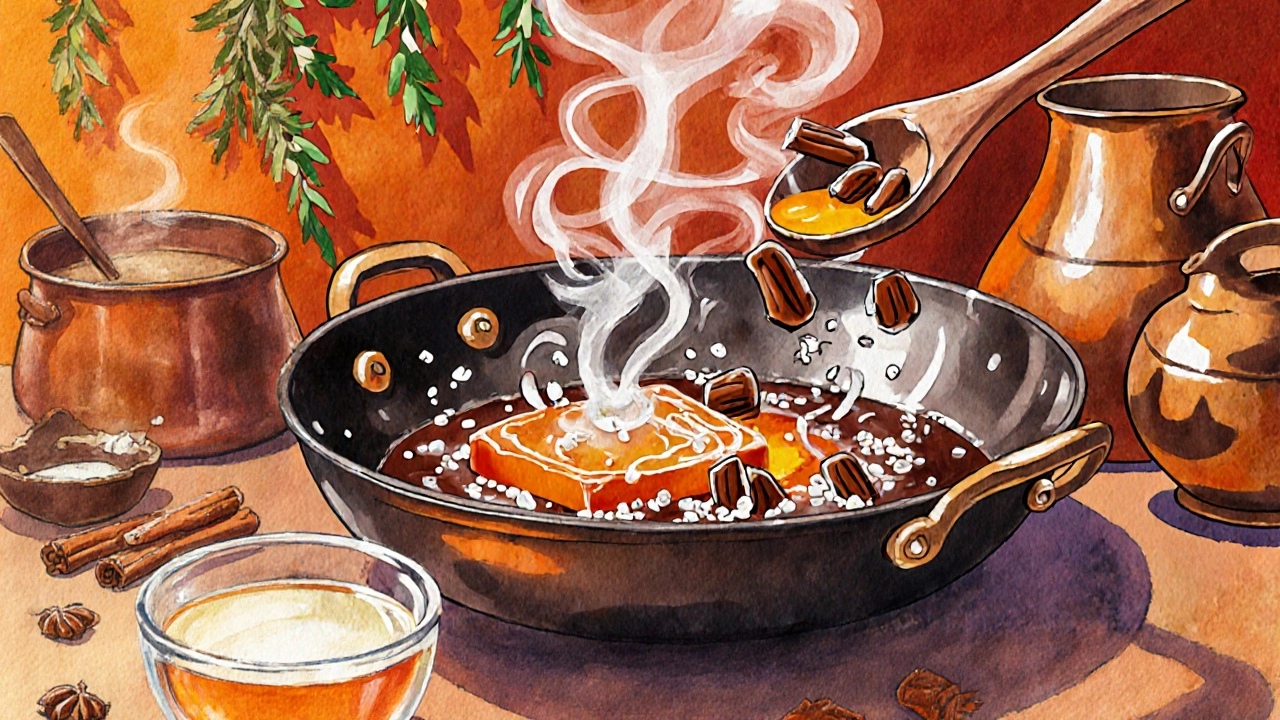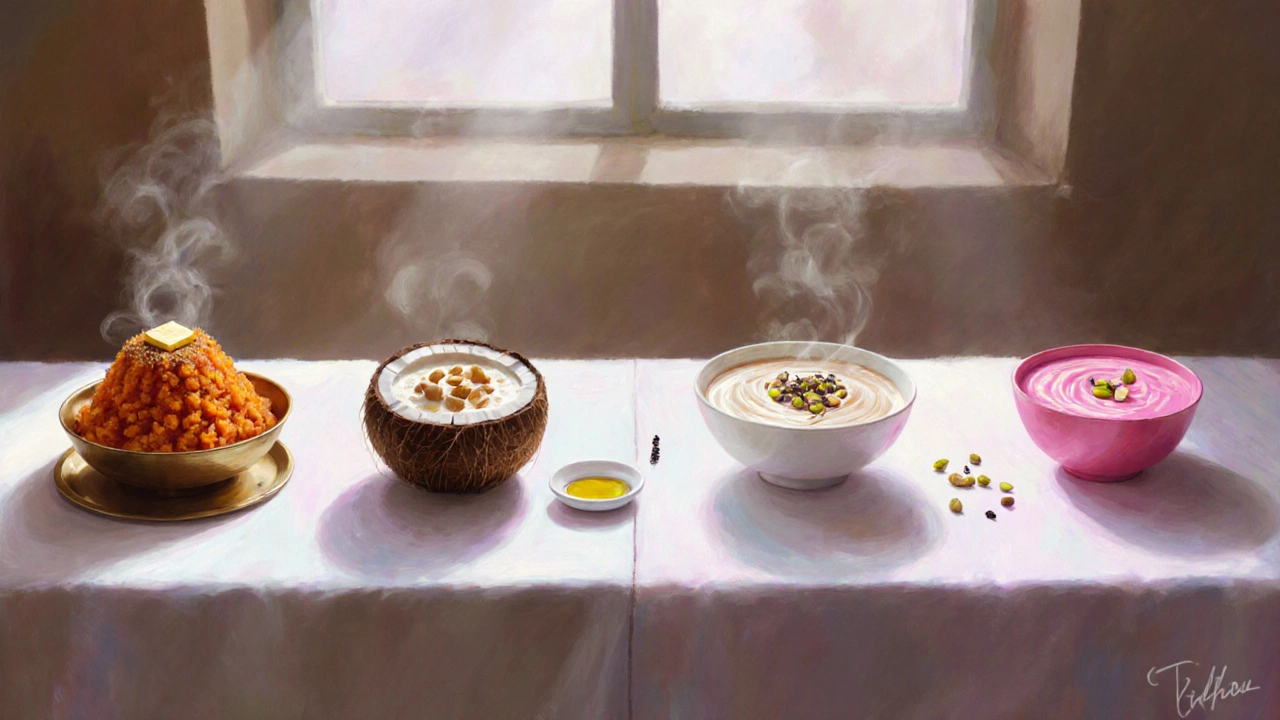Why Indian Food Tastes Sweet: Ingredients, Techniques, and Regional Secrets

Indian Sweetness Balance Calculator
How to Use
Enter your main sweetener type and amount. Choose your dish style and cooking method to get personalized recommendations.
When you bite into sweet taste in Indian food, you’re not just tasting sugar - you’re experiencing a blend of traditional sweeteners, aromatic spices, and cooking tricks that have been refined over centuries. Indian cooks balance sweetness with heat, sourness, and salt, creating dishes that feel both comforting and complex. This guide breaks down every ingredient and method that puts that distinctive sweet note on everything from curries to chutneys, and even savory biryanis.
What Makes Indian Food Sweet?
Unlike many Western cuisines that rely mostly on refined white sugar, Indian cuisine uses a handful of natural sweeteners and flavor boosters. These ingredients work on two levels:
- Base sweeteners - jaggery (unrefined cane sugar), palm sugar, honey, coconut sugar, and sometimes plain granulated sugar.
- Flavor enhancers - cardamom, saffron, rose water, fennel seeds, and even dried fruits such as raisins.
Both groups interact with spices like cumin, cinnamon, and cloves, turning a simple sweet note into a layered aroma that defines Indian food.
Traditional Sweeteners: The Heart of Indian Sweetness
Here are the most common sweeteners you’ll find in Indian kitchens, along with their key attributes.
| Sweetener | Source | Flavor Profile | Typical Uses |
|---|---|---|---|
| Jaggery | Boiled sugarcane or palm sap | Deep caramel, slight smoky notes | Traditional sweets (payasam), savory dishes (dal), chutneys |
| Granulated Sugar | Refined beet or cane | Pure, clean sweetness | Baklava‑style desserts, fruit‑based sauces, balancing spices |
| Honey | Bee‑produced nectar | Floral, light | Marinades, glazes for kebabs, drizzling over halwa |
| Coconut Sugar | Extracted from coconut palm sap | Nutty, slight caramel | South‑Indian desserts, vegan recipes, sweetening chutneys |
| Palm Sugar | Palms (date or sugar palm) | Rich, earthy caramel | Thai‑influenced Indian dishes, sweet soups |
Flavor Enhancers: Turning Sweet Into Aromatic
Once the base sweetness is set, Indian cooks add aromatics that make the sweet note sing.
- Cardamom - the “queen of spices.” Its citrusy‑spicy aroma lifts any sweet dish.
- Saffron - harvested from crocus petals, it gives a golden hue and a subtle hay‑like sweetness.
- Rose Water - distillation of rose petals; adds a perfumed floral layer.
- Fennel Seeds - anise‑like flavor, often used in sweets for a mild licorice kick.
- Dry Fruits (Raisins, Apricots) - natural sugars with chewy texture.

Cooking Techniques That Amplify Sweetness
Even the same ingredient can taste different depending on how it’s cooked. Indian chefs rely on a few key methods:
- Caramelization: Slow cooking sugar or jaggery over low heat releases deep amber tones. Classic examples are gulab jamun syrup and kadhai paneer glaze.
- Toasting Spices: Briefly heating whole spices in oil or ghee unlocks essential oils, which then blend with sweeteners. This is why a pinch of toasted cardamom changes a simple rice pudding dramatically.
- Layered Cooking: Adding sweeteners at different stages - early for base flavor, later for finishing shine - creates a multi‑dimensional sweet profile. For instance, biryani often gets a touch of sugar during rice par‑boiling and another hint of honey after plating.
- Infusion: Soaking saffron strands or rose petals in warm milk or water extracts their subtle sweetness without adding extra sugar.
Regional Sweetness: North vs. South
India’s vast geography means the sweet palate isn’t uniform.
- North India: Relies heavily on jaggery, milk solids (khoya), and aromatic spices. Dishes like gajar ka halwa combine grated carrots, khoya, and cardamom for a rich, buttery sweetness.
- South India: Uses coconut sugar, palm jaggery, and coconut milk. Staples such as payasam (a rice pudding) blend coconut milk, jaggery, and sometimes toasted cashews for a tropical sweet note.
- East India (Bengal): Famous for mustard‑infused sweets - the occasional dash of mustard oil balances the intense sweetness of mishti doi.
- West India (Gujarat, Maharashtra): Adds a salty-sweet twist, using sugar with a pinch of black salt in desserts like shrikhand.
Savory Dishes With a Sweet Edge
Sweetness isn’t limited to desserts. Many classic mains carry a subtle sweet background that makes them feel rounded.
- Chicken Korma: Yogurt and ground almonds create a mild sweet creaminess, enhanced with a hint of sugar.
- Rogan Josh: A splash of sugar balances the heat from Kashmiri chilies.
- Aloo Gobi: A pinch of jaggery during the final stir gives cauliflower a glossy, sweet‑savory coat.
- Masala Chai: While technically a beverage, the brew mixes black tea, milk, sugar, and spices-an everyday example of sweet taste integrated with bitterness.

Balancing Sweetness: Practical Tips for Home Cooks
Too much sweetener can overwhelm a dish, but the right amount adds depth. Keep these rules in mind:
- Start Small: Add sweeteners a teaspoon at a time and taste before deciding to add more.
- Use the Right Sweetener: For a caramel tone, choose jaggery; for a light floral lift, use honey or rose water.
- Counteract with Acidity: A splash of lemon juice or tamarind can tame excess sweetness while adding brightness.
- Consider Texture: Adding raisins or chopped dates brings natural sweetness plus chewiness, reducing the need for extra sugar.
- Mind the Cooking Stage: Adding sugar too early can cause burning; late addition preserves flavor.
Quick Reference Cheat‑Sheet
| Ingredient | Best Use | Flavor Note |
|---|---|---|
| Jaggery | Traditional sweets, dal, chutney | Deep caramel, earthy |
| Honey | Glazes, marinades, drizzling | Floral, light |
| Coconut Sugar | South‑Indian desserts, vegan dishes | Nutty, mild caramel |
| Cardamom | Rice puddings, halwa, chai | Citrusy‑spicy |
| Saffron | Biryanis, kheer, sweets | Hay‑like, aromatic |
| Rose Water | Gulab jamun syrup, desserts | Perfumed floral |
Frequently Asked Questions
Why does Indian food taste sweeter than other cuisines?
Indian recipes often combine natural sweeteners like jaggery with aromatic spices such as cardamom and saffron. These layers create a sweet impression even in savory dishes.
Can I replace jaggree with regular sugar?
You can, but you’ll lose the deep caramel flavor. If you need a quick swap, add a tiny pinch of molasses to mimic jaggery’s richness.
Is rose water safe for everyday cooking?
Yes, a few drops add fragrance without extra calories. Use it in syrups, desserts, and even in savory marinades for a subtle lift.
How much sugar should I add to a curry?
Start with ½ teaspoon per serving. Taste, then adjust. Remember you can always balance with a splash of lemon or tamarind if it gets too sweet.
What’s the healthiest sweetener for Indian dishes?
Coconut sugar and raw honey provide nutrients and have a lower glycemic impact compared to refined sugar, but moderation is key for any sweetener.